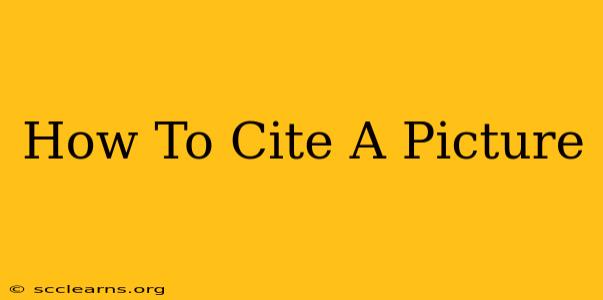Citing images correctly is crucial for academic integrity and avoiding plagiarism. Whether you're writing a research paper, creating a presentation, or composing a blog post, knowing how to properly cite a picture is essential. This guide will walk you through the process, covering various citation styles and offering helpful tips.
Understanding the Importance of Image Citation
Failing to cite images can have serious consequences. It's considered plagiarism, which can lead to academic penalties or legal issues depending on the context. Proper citation gives credit to the creator, demonstrates your research diligence, and allows readers to locate the original source. It also protects you from accusations of intellectual property theft.
Key Information Needed for Image Citations
Before you begin, gather the following information about your image:
- Author/Creator: The name of the person or organization that created the image.
- Title of Image (if applicable): The title given to the image by the creator. If no formal title exists, a descriptive title can be used (e.g., "Photograph of a Redwood Forest").
- Source: Where you found the image. This could be a website URL, a book, a database, or a museum.
- Date of Creation (if known): The date the image was created.
- Date of Access: The date you downloaded or viewed the image.
Citation Styles: MLA, APA, Chicago, and More
Different citation styles require slightly different formatting. Here's a breakdown of how to cite images in some common styles:
MLA (Modern Language Association)
MLA style generally favors in-text citations and a Works Cited page. For an image from a website, the citation might look like this:
- In-text citation: (Image Title Author's Last Name).
- Works Cited entry:
Author's Last Name, Author's First Name. "Image Title." Website Name, URL, Date of Access.
Example:
(Redwood Forest Smith).
Smith, John. "Redwood Forest." National Geographic, www.nationalgeographic.com/redwood-forest, 15 October 2023.
APA (American Psychological Association)
APA style also utilizes in-text citations and a References page. The focus is on the source and date.
- In-text citation: (Author's Last Name, Year).
- References entry:
Author's Last Name, Author's First Name. (Year). Image Title. [Image]. Retrieved from URL
Example:
(Smith, 2023).
Smith, J. (2023). Redwood Forest. [Image]. Retrieved from www.nationalgeographic.com/redwood-forest
Chicago Style
Chicago style offers both notes-bibliography and author-date systems. The notes-bibliography system uses footnotes or endnotes for citations, while the author-date system is similar to APA.
- Notes-Bibliography Example (Footnote):
¹ John Smith, "Redwood Forest," National Geographic (www.nationalgeographic.com/redwood-forest, accessed October 15, 2023).
- Bibliography Entry:
Smith, John. "Redwood Forest." National Geographic. Accessed October 15, 2023. www.nationalgeographic.com/redwood-forest.
Other Styles
Many other citation styles exist, such as Turabian and CSE. Consult your style guide for specific instructions.
Tips for Effective Image Citation
- Always obtain permission: If you are unsure about the copyright status of an image, it's best to obtain permission from the copyright holder before using it.
- Use high-quality images: Choose images that are clear, relevant, and visually appealing.
- Properly attribute images: Make sure the citation is clear, accurate, and easy to find.
- Check your institution's guidelines: Your school or organization may have specific requirements for image citation.
By following these guidelines, you can ensure that you are citing images correctly and avoiding any potential problems related to plagiarism. Remember, proper citation is a mark of academic integrity and responsible research.

